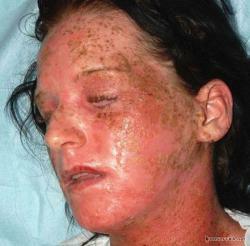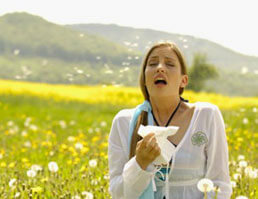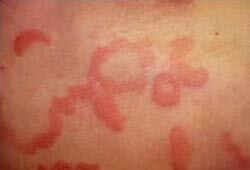alergijos gydymas.Apžvalga trečiosios kartos antihistamininiai vaistai
| loratadine CLARITINE | cetirizine ZYRTEC | ebastine KESTINE | |
| comparative | |||
| Efficiency | +++ | +++ | +++ |
| | 24 hours | 24 hours | 48 h. |
| | 0,5 hours | 1 hour | 1 hour |
| dosing frequency | 1 r / d |
1 r / d | 1 r / d |
| unwanted | |||
| Elongation | no | no | No |
| Sedative | no | RARE | no |
| Strengthening | no | YES | no |
| side effects when combined with ketoconazole and erythromycin | no | no | YES |
| Dovelichenie | no | no | no |
| application | |||
| Ability | & gt;2 years | & gt;2 years | & gt;12 years |
| Application | possible | not | contraindicated |
| Application | contraindicated | contraindicated | is contraindicated |
| Need for | no | no | no |
| | no | YES | YES |
| Necessity | function is not | no | contraindicated |
| cost | |||
| cost | 0,57 | 0,70 | 0,57 |
| The cost of the | 17,1 | 21 | 17,1 |
| astemizole HISMANAL | terfenadine TREXYL | fexofenadine TELFAST | |
| comparative | |||
| Efficiency | +++ | +++ | +++ |
| | 24 hours | 18 - 24 hours | 24 hourand |
| | 1 hour | 1 hour | 1 hour |
| frequency | 1 r / d | 1-2 p / d | 1 r / d |
| | |||
| Elongation | YES | YES |
na |
| Sedative | no | no | no |
| Strengthening | no | no | no |
| side effects when combined with ketoconazole and erythromycin | YES | YES | no |
| Increase | YES | no | no |
| application | |||
| Possibility | & Gt;1 | & gt;3 years | & gt;12 years |
| Application | possible | contraindicated | possible |
| Application | contraindicated | contraindicated |
is contraindicated |
| The need for dose reduction | no | no | no |
| | no | no | YES |
| Necessity | function contraindicated | contraindicated | no |
| cost | |||
| cost |
| ||
| The cost of the | 11.1 | - | 16,2 |
 Spring.Nature awakens. .. Primrose blossoms. .. Birch, alder, poplar, hazel let out coquettish earrings;Buzzing bees, bumblebees, collecting pollen. .. The season of pollinosis begins( from the Latin pollinis of pollen) or hay fever - allergic reactions to pollen of plants.Summer comes.Blossom of cereals, tart sage, fragrant lavender. .. Then comes autumn and "mistress" is ragweed, the pollen of which is the most dangerous allergen.During flowering weed, up to 20% of the population suffers from lacrimation, coughing, allergic rhinitis.And the long-awaited Available winter.But there's a lot waiting for cold allergy.Again spring. .. And so all year round.
Spring.Nature awakens. .. Primrose blossoms. .. Birch, alder, poplar, hazel let out coquettish earrings;Buzzing bees, bumblebees, collecting pollen. .. The season of pollinosis begins( from the Latin pollinis of pollen) or hay fever - allergic reactions to pollen of plants.Summer comes.Blossom of cereals, tart sage, fragrant lavender. .. Then comes autumn and "mistress" is ragweed, the pollen of which is the most dangerous allergen.During flowering weed, up to 20% of the population suffers from lacrimation, coughing, allergic rhinitis.And the long-awaited Available winter.But there's a lot waiting for cold allergy.Again spring. .. And so all year round.
And yet off-season allergy to animal hair, cosmetics, homelinessand so on.Plus, drug allergy, food.In addition, in recent years, the diagnosis of "allergies" is raised more often, and manifestations of the disease are more pronounced.
Facilitate the condition of patients with drugs that relieve the symptoms of allergic reactions, and above all - antihistamines( AHP).Histamine, stimulating H1-receptors, can be called the main culprit of the disease.He participates in the mechanism of the emergence of the main manifestations of allergies.Therefore, antihistamines are always prescribed as antiallergic drugs.
Antihistamines - blockers of H1 histamine receptors: properties, mechanism of action
Mediator( biologically active mediator) histamine affects:
- Skin, causing itching, flushing.
- Respiratory tract, provoking edema, bronchospasm.
- Cardiovascular system, causing increased vascular permeability, cardiac rhythm disturbance, hypotension.
- Gastrointestinal tract, stimulating gastric secretion.
Antihistamines relieve symptoms caused by endogenous release of histamine.They interfere with the development of hyperreactivity, but do not affect the sensitizing effect( hypersensitivity) of allergens, nor on the infiltration of mucous eosinophils( the type of leukocytes: their content in the blood increases with allergies).
Antihistamines:
-
 significantly reduces the histamine-induced increase in capillary permeability;
significantly reduces the histamine-induced increase in capillary permeability; - relieves spasms of smooth muscles;
- prevents tissue edema formation;
- reduces the toxicity of histamine;
- reduces the hypotensive effect of histamine;
- alleviate the condition with allergies.
It should be borne in mind that not only histamine belongs to mediators involved in the pathogenesis( mechanism of occurrence) of allergic reactions.Besides him, acetylcholine, serotonin and other substances are "guilty" of inflammatory and allergic processes.Therefore, drugs that have only antihistamine activity, stop only acute manifestations of allergies.Systematic treatment requires complex desensitizing therapy.
Generations of antihistamines
We recommend to read: 
Three groups( generations) of antihistamines are distinguished according to the current classification:
H1, first generation histamine blockers( tavegil, dimedrol, suprastin) - penetrate through a special filter - blood-brain barrierGEB), act on the central nervous system, providing a sedative effect;
H1 second-generation histamine blockers( fenkarol, loratadine, ebastin) - do not cause sedation( in therapeutic doses);
H1 histaminoblockers of the third generation( telphast, erius, zirtek) are pharmacologically active metabolites.Do not pass through the BBB, the CNS is minimal, so do not cause sedation.
The characteristics of the most popular antihistamines are given in the Table:
The benefits of antihistamines 3 generations
This group combines pharmacologically active metabolites of some drugs of previous generations:
- fexofenadine( telphast, fexofast) is an active metabolite of terfenadine;
- levocetirizine( xisal) - a derivative of cetirizine;
- desloratadine( erius, desal) is an active metabolite of loratadine.
The latest generation of drugs is characterized by a significant selectivity( selectivity), they act solely on peripheral H1 receptors. Hence the advantages of :
- Efficacy: rapid absorption plus high bioavailability determine the rate of removal of allergic reactions.
- Practicality: does not affect performance;The absence of a sedative effect plus cardiotoxicity cancels the need to adjust the dose to elderly patients.
- Safety: do not become addictive - it allows you to prescribe long courses of therapy.Practically there is no interaction with concurrently taken drugs;Absorption is not dependent on food intake;The active substance is output "as is"( unchanged), i.e., the target organs( kidneys, liver) do not suffer.
Assign medicines for seasonal and chronic rhinitis, conjunctivitis, dermatitis, bronchospasm of an allergic nature.
Antihistamines 3 generations: names and dosages
Please note: dosages are indicated for adults.
Fexadine, telphast, fexofast take 120-180 mg x once a day.Indication: symptoms of hay fever( sneezing, itching, rhinitis), idiopathic urticaria( redness, itching).
Levocetirizine-teva, xizal take 5 mg x 1 time per day.Indications: chronic allergic rhinitis, idiopathic urticaria.
Desloratadine-teva, erius, dezal take 5 mg x 1 time per day.Indications: seasonal pollinosis, chronic idiopathic urticaria.
Third-generation antihistamines: side effects
With its relative safety, the third-generation histamine receptor blockers H1 can cause: agitation, convulsions, dyspepsia, abdominal pain, myalgia, dry mouth, insomnia, headache, asthenic syndrome, nausea, drowsiness, Dyspnoea, tachycardia, visual impairment, weight gain, paronymy( unusual dreams).
Antihistamines for children
Xylol in drops prescribed for children: over 6 years in a daily dose of 5 mg( = 20 drops);From 2 to 6 years in a daily dose of 2.5 mg( = 10 drops), more often by 1.25 mg( = 5 drops) x 2 times a day.
Levocetirizine-teva - dose for children over 6 years: 5 mg x 1 time per day.
Eryus syrup is allowed for children aged 1 to 6 years: 1.25 mg( = 2.5 ml syrup) x once a day;From 6 to 11 years: 2.5 mg( = 5 ml of syrup) x once a day;
adolescents from 12 years: 5 mg each( = 10 ml syrup) x once a day.
Erius is able to inhibit the development of the first phase of an allergic reaction and inflammation.In the case of chronic urticaria, reverse development of the disease occurs.The therapeutic efficacy of erius in the treatment of chronic urticaria is confirmed in a placebo-controlled( blind) multicenter study.Therefore, erius is recommended for use in children from one year old.
Important : a study of the effectiveness of the eryus in the form of tablets for resorption in the children's group was not carried out.But the pharmacokinetic data revealed in the study of the determination of drug doses with the participation of patients-children, indicate the possibility of using pastilles of 2.5 mg in the age group 6-11 years.
Fexofenadine 10 mg is given to adolescents from 12 years of age.
Allergy medications and their application in pediatrics are told by the doctor:
Prescribing antihistamines during pregnancy
Pregnant antihistamines of the third generation are not prescribed.In exceptional cases, the use of telphast or fexofast is allowed.
Important : information on the use of fexofenadine( telphast) drugs by pregnant women is not enough.Since studies conducted on experimental animals have not revealed signs of adverse effect of telphast on the general course of pregnancy and intrauterine development, the drug is considered conditionally safe for pregnant women.
Antihistamines: from dimedrol to erysus
The first generation of antihistamines, many allergy sufferers are obliged to improve their health."Side" drowsiness was perceived as a reality: but it does not flow from the nose and does not itch.Yes, the quality of life suffered, but what to do - a disease.The latest generation of antihistamines has enabled a large cohort of allergy sufferers to not only get rid of the allergy symptoms, but also to live a normal life: driving a car, playing sports, without risking "falling asleep".
4-generation antihistamines: myths and reality
 Often, the term "anti-histamine drug of the new generation", "antihistamine drug of the fourth generation" slips in advertising of allergy treatment drugs.And this non-existent group is often considered not only the antiallergic drugs of the last generation, but also medicines under new trademarks relating to the second generation.This is nothing more than a marketing gimmick.In the official classification, only two groups of antihistamines are indicated: the first generation and the second.The third group is pharmacologically active metabolites, followed by the term "H1 histamine blockers of the third generation".
Often, the term "anti-histamine drug of the new generation", "antihistamine drug of the fourth generation" slips in advertising of allergy treatment drugs.And this non-existent group is often considered not only the antiallergic drugs of the last generation, but also medicines under new trademarks relating to the second generation.This is nothing more than a marketing gimmick.In the official classification, only two groups of antihistamines are indicated: the first generation and the second.The third group is pharmacologically active metabolites, followed by the term "H1 histamine blockers of the third generation".
Clinical pharmacologist, doctor of the highest category Nazarova Marina Sergeevna



